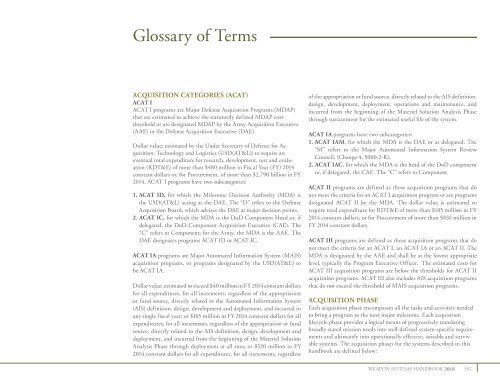AMERICA’S ARMY WINNING IN A COMPLEX WORLD
431298
431298
You also want an ePaper? Increase the reach of your titles
YUMPU automatically turns print PDFs into web optimized ePapers that Google loves.
Glossary of Terms<br />
ACQUISITION CATEGORIES (ACAT)<br />
ACAT I<br />
ACAT I programs are Major Defense Acquisition Programs (MDAP)<br />
that are estimated to achieve the statutorily defined MDAP cost<br />
threshold or are designated MDAP by the Army Acquisition Executive<br />
(AAE) or the Defense Acquisition Executive (DAE).<br />
Dollar value: estimated by the Under Secretary of Defense for Acquisition,<br />
Technology and Logistics (USD(AT&L)) to require an<br />
eventual total expenditure for research, development, test and evaluation<br />
(RDT&E) of more than $480 million in Fiscal Year (FY) 2014<br />
constant dollars or, for Procurement, of more than $2.790 billion in FY<br />
2014. ACAT I programs have two subcategories:<br />
1. ACAT ID, for which the Milestone Decision Authority (MDA) is<br />
the USD(AT&L) acting as the DAE. The “D” refers to the Defense<br />
Acquisition Board, which advises the DAE at major decision points.<br />
2. ACAT IC, for which the MDA is the DoD Component Head or, if<br />
delegated, the DoD Component Acquisition Executive (CAE). The<br />
“C” refers to Component; for the Army, the MDA is the AAE. The<br />
DAE designates programs ACAT ID or ACAT IC.<br />
ACAT IA programs are Major Automated Information System (MAIS)<br />
acquisition programs, or programs designated by the USD(AT&L) to<br />
be ACAT IA.<br />
Dollar value: estimated to exceed $40 million in FY 2014 constant dollars<br />
for all expenditures, for all increments, regardless of the appropriation<br />
or fund source, directly related to the Automated Information System<br />
(AIS) definition, design, development and deployment, and incurred in<br />
any single fiscal year; or $165 million in FY 2014 constant dollars for all<br />
expenditures, for all increments, regardless of the appropriation or fund<br />
source, directly related to the AIS definition, design, development and<br />
deployment, and incurred from the beginning of the Materiel Solution<br />
Analysis Phase through deployment at all sites; or $520 million in FY<br />
2014 constant dollars for all expenditures, for all increments, regardless<br />
of the appropriation or fund source, directly related to the AIS definition,<br />
design, development, deployment, operations and maintenance, and<br />
incurred from the beginning of the Materiel Solution Analysis Phase<br />
through sustainment for the estimated useful life of the system.<br />
ACAT IA programs have two subcategories:<br />
1. ACAT IAM, for which the MDA is the DAE or as delegated. The<br />
“M” refers to the Major Automated Information System Review<br />
Council. (Change 4, 5000.2-R).<br />
2. ACAT IAC, for which the MDA is the head of the DoD component<br />
or, if delegated, the CAE. The “C” refers to Component.<br />
ACAT II programs are defined as those acquisition programs that do<br />
not meet the criteria for an ACAT I acquisition program or are programs<br />
designated ACAT II by the MDA. The dollar value is estimated to<br />
require total expenditure for RDT&E of more than $185 million in FY<br />
2014 constant dollars, or for Procurement of more than $835 million in<br />
FY 2014 constant dollars.<br />
ACAT III programs are defined as those acquisition programs that do<br />
not meet the criteria for an ACAT I, an ACAT IA or an ACAT II. The<br />
MDA is designated by the AAE and shall be at the lowest appropriate<br />
level, typically the Program Executive Officer. The estimated costs for<br />
ACAT III acquisition programs are below the thresholds for ACAT II<br />
acquisition programs. ACAT III also includes AIS acquisition programs<br />
that do not exceed the threshold of MAIS acquisition programs.<br />
ACQUISITION PHASE<br />
Each acquisition phase encompasses all the tasks and activities needed<br />
to bring a program to the next major milestone. Each acquisition<br />
lifecycle phase provides a logical means of progressively translating<br />
broadly stated mission needs into well-defined system-specific requirements<br />
and ultimately into operationally effective, suitable and survivable<br />
systems. The acquisition phases for the systems described in this<br />
handbook are defined below:<br />
WEAPON SYSTEMS HANDBOOK 2016 357


